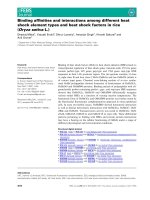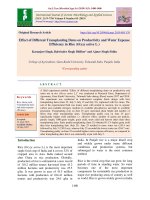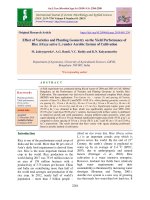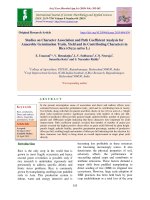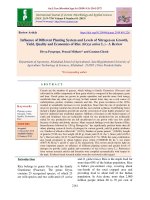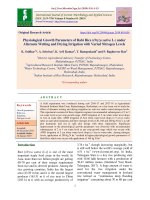Effect of soil improver on growth, yield and accumulation of cadmium on rice (oryza sativa l ) under cadmium contaminated soil
Bạn đang xem bản rút gọn của tài liệu. Xem và tải ngay bản đầy đủ của tài liệu tại đây (2.67 MB, 94 trang )
VIETNAM NATIONAL UNIVERSITY OF AGRICULTURE
FACULTY OF AGRONOMY
UNDERGRADUATE THESIS
TITLE:
“EFFECTS OF SOIL IMPROVER ON GROWTH,
YIELD AND ACCUMULATION OF CADMIUM ON
RICE (Oryza sativa L.) UNDER CADMIUM
CONTAMINATED SOIL”
Supervisor
: PhD. Nguyen Thi Ngoc Dinh
Department : Experimental Methods and Biostatistics
Student
: Nguyen Thi Phuong
ID code
: 611716
Class
: K61 - KHCTT
Course
: 2016 - 2020
HANOI - 2021
DECLARATION
I hereby declare that this paper is my own work. All results and data in
this title are absolutely honest and have not been submitted before to any
institution for assessment purposes. All sources used in this paper were cited in
references.
Hanoi, ………………, 2021
Student
i
ACKNOWLEDGEMENTS
To complete this thesis, I am deeply indebted to people who have been
providing me with precious support and advice.
Firstly, I would like to send my gratitude to my supervisor, PhD. Nguyen
Thi Ngoc Dinh, Department of Experimental Methods and Biostatistics, Faculty
of Agronomy, Vietnam National University of Agriculture, for her enthusiastic
support, helpful advice and considerable encouragement in the completion of
my thesis. Besides my advisor, I would like to thank the rest of the teachers of
Agronomy Faculty of the Viet Nam National University of Agriculture: for their
encouragement, supporting and advising.
Last but not least, I want to express my sincere thanks to my family and
intimate friends who have always been by my side, give me support and strength
to complete this graduation thesis.
ii
CONTENTS
DECLARATION ................................................................................................ i
ACKNOWLEDGEMENTS................................................................................ ii
CONTENTS ...................................................................................................... iii
CONTENT OF TABLE .................................................................................... vi
CONTENT OF GRAPH .................................................................................. viii
CONTENT OF ACRONYMS ........................................................................... ix
ABSTRACT ....................................................................................................... x
CHAPTER I. INTRODUCTION .................................................................... 1
1.1.
Rationale of study .................................................................................... 1
1.2.
Objectives ................................................................................................ 4
1.3.
Requirements ........................................................................................... 4
CHAPTER II. LITERATURE REVIEW ...................................................... 5
2.1.
Theoretical basis ...................................................................................... 5
2.1.1. Characteristics of rice and effects of external factors to rice ..................... 5
2.1.2. Characteristics of soil improvers .............................................................. 8
2.1.3. Heavy metal Cadmium content in soil ...................................................... 9
2.1.4. Heavy metal concept ................................................................................ 9
2.1.5. The impacts of heavy metals on plants ................................................... 12
2.1.6. Accumulation of heavy metals in crop products ..................................... 13
2.1.7. Toxicity of heavy metals to plants .......................................................... 13
2.1.8. Accumulation of heavy metals in productivy of rice ............................... 14
2.2.
Practical basis ........................................................................................ 15
2.2.1. The results of research in the world related to the effects of soil improver
is to limit the negative effects of heavy metal Cadmium to growth plant.
............................................................................................................... 15
iii
2.2.2. The results of research in Vietnam related to the effects of soil improver is
to limit the negative effects of heavy metal Cadmium to growth plant ... 19
CHAPTER III. MATERIALS AND METHODS ......................................... 21
3.1.
Materials ................................................................................................ 21
3.1.1. Plant materials ....................................................................................... 21
3.2.
Location and time .................................................................................. 21
3.3.
Research content .................................................................................... 21
3.4.
Methods ................................................................................................. 22
3.5.
Cultivation methods ............................................................................... 22
3.5.1. Time of seasonal .................................................................................... 22
3.5.2. Plant techniques ..................................................................................... 22
3.6.
Data collection ....................................................................................... 23
3.7.
Data analysis .......................................................................................... 25
CHAPTER IV. RESULT AND DISCUSSION ............................................. 26
4.1.
Heavy metal contaminated soil in regions .............................................. 26
4.2.
Effects of soil improver on growth characteristics of rice under
contaminated cadmium soil .................................................................... 27
4.2.1. The effects of soil improver on the plant height of rice under contaminated
Cadmium soil ......................................................................................... 27
4.2.2. The effects of soil improver on the number of leaves of rice rice under
contaminated Cadmium soil ................................................................... 30
4.2.3. The effects of soil improver on the number of branch of rice rice under
contaminated Cadmium soil ................................................................... 31
4.3. The effects of soil improver on the physiological indicators of rice under
contaminated cadmium soil .................................................................... 33
4.3.1.The effects of soil improver on the SPAD of rice under contaminated
Cadmium soil ......................................................................................... 33
iv
4.3.2. The effects of soil improver on the leaf area of rice under contaminated
Cadmium soil ......................................................................................... 35
4.3.3. The effects of soil improver on the stem dry weight of rice under
contaminated Cadmium soil ................................................................... 36
4.3.4. The effects of soil improver on the leaf dry weight of rice under
contaminated Cadmium soil ................................................................... 37
4.3.5. The effects of soil improver on the indicates thin, thickness leaf of rice
under contaminated Cadmium soil ......................................................... 38
4.4.
The effects of soil improver on yield component and grain yield of rice
under contaminated cadmium soil .......................................................... 42
4.5.
Correlation between grain yield and Cd accumulation in rice grain........ 49
CHAPTER V. CONCLUSION AND RECOMMENDATION .................... 50
5.1.
Conclusion ............................................................................................. 50
5.2.
Recommendation ................................................................................... 51
REFERENCES ............................................................................................... 53
THE FIGURE DURING CARRYING OUT THE EXPERIMENT .................. 57
DATA TO RUN IRRISTAT ............................................................................ 63
v
CONTENT OF TABLE
Table 2.1. Typical ranges of heavy metal concentrations in fertilizers,
farmyard......................................................................................... 11
Table 2.2. Concentrations of heavy metals in fertilizer .................................... 11
Table 2.3. FAO/WHO maximum permissible values of heavy metals in
vegetables ...................................................................................... 15
Table 2.4. Safety limits suggested by Malaysian food Act (1983) and food
regulations (1985) for some heavy metals in vegetables ................. 15
Table 4.1. Names and locations of sampling stations for paddy soils and
paddy rice samples ......................................................................... 26
Table 4.2. The effects of soil improver on the plant height of rice under
contaminated Cadmium soil ........................................................... 28
Table 4.3. The effects of soil improver is on the number of leaves of rice
rice under contaminated Cadmium soil .......................................... 30
Table 4.4. The effects of soil improver on the number of branch of rice
rice under contaminated Cadmium soil .......................................... 32
Table 4.5. The effects of soil improver on the SPAD of rice under
contaminated Cadmium soil ........................................................... 34
Table 4.6. The effects of soil improver on the leaf area of rice under
contaminated Cadmium soil ........................................................... 35
Table 4.7. The effects of soil improver on the stem dry weight of rice
under contaminated Cadmium soil ................................................. 36
Table 4.8. The effects of soil improver on the leaf dry weight of rice
under contaminated Cadmium soil ................................................. 37
Table 4.9. The effects of soil improver on the indicates thin, thickness
leaf of rice under contaminated Cadmium soil ............................... 38
vi
Table 4.10. The effects of soil improver on the panicle dry weight of rice
under contaminated Cadmium soil ................................................. 39
Table 4.11. The effects of soil improver on the root dry weight of rice
under contaminated Cadmium soil ................................................. 40
Table 4.12. The effects of soil improver on the total dry weight of rice
under contaminated Cadmium soil ................................................. 41
Table 4.13. The effects of soil improver on panicles number / plant of rice
under contaminated Cadmium soil ................................................. 42
Table 4.14. The effects of soil improver on the number of filled and
unfilled grains per panicle under contaminated Cadmium soil ..... 43
Table 4.15. The effects of soil improver on the 1000 grain weight of rice
under contaminated Cadmium soil ................................................. 45
Table 4.16. The effects of soil improver on grain yield of rice under
contaminated Cadmium soil ........................................................... 46
Table 4.17. Cadmium accumulation in rice grain after cultivating rice
plants in Cd-contaminated soil with/without the addition of
soil improver .................................................................................. 47
Table 4.18. Cadmium accumulation in soil after cultivating rice plants in
Cd-contaminated soil with/without the addition of soil
improver......................................................................................... 48
vii
CONTENT OF GRAPH
Graph 4.1. The growth dynamics of plant height of rice ........................................... 27
Graph 4.2. The total dry weight of rice .................................................................... 41
Graph 4.3. The correlation between grain yield and Cd accumulation in rice
grain, significant at P < 0.01. .................................................................. 49
viii
CONTENT OF ACRONYMS
CT
Treatment
DAS
After day sowing
DMC
Dry matter content
FAO
Food and Agriculture Organization of the United Nations
LA
Leaf Area
RCBD
Randomized Complete Block Design
TY
Total Yield
ix
ABSTRACT
The experiment was conducted to investigate the effects of soil improver
is to limit the negative effects of heavy metal Cadmium to growth and the
accumulation of Cadmium in productivity of rice (Oryza sativa L.). The soil
improver was applied to contaminated Cd paddy soil at various application rates
(no added soil improver (control); biochar 2.5 % (w/w); straw rice 2.5% (w/w),
biochar 5 % (w/w), straw rice 5% (w/w); mix 1-1 2.5 % (biochar was mixed
with straw rice), mix 1-1 5 %) (biochar was mixed with straw rice). The
experimental results indicated that biochar treatments reduced Cd concentrations
accumulation grain rice, the soil improver promoted rice growth and the
productivity. The application rates of more 2.5 % biochar and straw rice were
considered to be reasonable for both rice growth and remediation of Cdcontaminated soil. Contaminated soil improver (more 2.5 % of biochar and
straw rice treatments) reduced the Cd content of individual rice plants and
ensured the normal growth of rice. The results application concentration 5 %
biochar treatment showed that the growth and yield of rice had the significant
higher as compared with other treatments and the concentration of cadmium in
rice grain was safety limits of (< 0.05 mg / kg) (Laboratory of soil and water,
Thuy Loi University (2020). In short, soil improver with 5 % biochar which
could promote effectively the growth of rice and greatly reduced grain rice Cd
uptake.
Keywords: biochar, straw rice, mix 1-1, rice, accumulation, cadmium
x
CHAPTER I. INTRODUCTION
1.1. RATIONALE OF STUDY
Along with the economic growth of the whole country, Vietnam's
agriculture in recent years has gained significant achievements, in general, the
productivity of crops has increased, daily life of workers has increased and
increasingly improved. In addition to the achievements, the use of large
quantities and improper chemical fertilizers and pesticides have reduced the
quality of agricultural products, in addition to the waste of factories industrial,
industrial and urban wastewater contaminate soil, water, and agricultural
products, adversely affecting public health, especially in industrial and large
cities.
Heavy metals are important contaminants in the environment, especially in
areas where there is high anthropogenic pressure. Cadmium is a non essential
element and is the fifth most toxic metal to vertebrates and the fourth
most toxic metal to vascular plants. It is believed that contamination of
water sources and agricultural lands with fertilizers and agrochemicals for long
periods of time is the main reason for accumulation of Cd. Bandaraetal. (2008)
and Premarathnaet (2011) reported that the triple super phosphate (TSP) used
by the Sri Lankan farmers carried 23.50 to 71.4 mg/Cd/Kg of P 2O5 and
433 commonly used weedicides in rice cultivation in Sri Lanka known as
bispyribac sodium contains 0.5mg/l of Cd. Therefore, heavy Cd accumulation
in agricultural soil can become dangerous to crops. When growing of plants in
Cd polluted area, Cd is readily taken up by plant roots and translocated in to
leaves in many plant species
Besides, Cadmium (Cd) is among the most toxic heavy metals deposited in
agricultural soils through natural means and man-made activities like the
application of sewage sludge containing Cd contents, application of phosphate
1
fertilizers, and waste disposal as well as metal smelting. It is found as a mineral
combined with other elements (cadmium oxide and cadmium chloride). The
main sources of Cd toxicity are from mines, paints, atmospheric deposition and
fertilizers (super-phosphate). Cd has a serious impact on the human body; it
accumulates in the human body daily, the average amount of Cd accumulated in
the human body at age 50 is 30 mg. Furthermore, high dose of Cd can lead to
lung cancer and high blood pressure. Cd can replace calcium in the bones
leading to the fragility and distortions for bones. It can also affect the immune
system and causes prostate cancer, heart disease and anemia. “Itai Itai causing
bone deformation and death occurred in the early 1970s in Japan when people
consumed rice containing Cd with the concentration of 0.5 to 1 mg/kg”
(Alloway B et al.,1993).
Cadmium toxicity in agricultural soils is a serious threat to crop production
worldwide. Even at low concentration and due to its nonessential form in living
organisms,Cd becomes highly toxic to both growing plant and animals, thus,
affecting plant morphologically, physiologically, and biochemically during
growth. Cadmium can be taken up by rice roots and then translocated to shoots
and grains of growing rice.The most common visible symptoms of Cd toxicity
in growing rice plants include reduction in plant growth and development,
chlorosis, and eventually plant death. High Cd accumulation in rice consumed
by animals, especially humans, poses several health implications such as cardiac
failure, anemia, cancer, hypertension, emphysema, proteinuria, cerebrovascular
infarction, damage to the lungs, renal dysfunction in eyes, and osteoporosis.
Recently, studies have paid considerable attention to soil amendments such
as biochar and rice straw that decreasing the bioavailability of heavy metals in
soils whilst promoting plant growth. According to reported of (XuanChen,
Hong-Zhi He, Gui-KuiChen & Hua-Shou Li, 2020) biochar is a carbon-rich
solid material made by pyrolysis of biomass under oxygen limited conditions.
2
Typically, the physical and chemical properties of biochar what make it
environmentally friendly, biochar has a high porosity and large specific surface
area, and strong ion exchange capacity, which offer a great potential for
application to soils for carbon sequestration, greenhouse gas emission reduction,
soil fertility improvement, and contaminated soil remediation. Biochar is used as
a soil conditioner to improve soil fertility as well as to adjust the soil pH,
moisture, air, and temperature conditions.
In a similar way, the application of rice straw as a fixative in soil
contaminated with heavy metals may play an effective role for metal
bioavailability. Rice straw, as the main by-product of crops, not only has a
positive effect on the soil structure, but also can loosen the soil, promoting the
growth and development of crops. Moreover, many studies (Kim, H. B. et al.
2018) have demonstrated that straw returned to the field could produce
dissolved organic carbon which acted as an organic ligand to adsorb heavy
metals in the soil.
Heavy metal pollution is a global environmental problem and regarding
food security and public health. Vietnam is one of the world's richest
agricultural regions and is the second-largest (after Thailand) exporter
worldwide and the world's seventh-largest consumer of rice. However, with the
rapid development of industry in the last century, large areas of paddy soil have
been contaminated by heavy metals because of sewage irrigation and rice is the
most planted crop in this contaminated soil. Rice is a staple food in Vietnam's
population and has very important planting status in Vietnam. However, in
recent years, it is not uncommon to find the reports that the cadmium content of
rice has exceeded the standard due to soil pollution. Currently, is necessary to
research the best soil improver to deal with these problems. Therefore, we
carried out this experiment with title "The effect of soil improver is to limit the
3
negative effects of heavy metal Cadmium to growth and the accumulation of
Cadmium in productivity of rice (Oryza sativa L.)."
1.2. OBJECTIVES
To find the soil improver is to limit the negative of heavy metal Cadmium
to growth and the accumulation of Cadmium in productivity of rice
1.3. REQUIREMENTS
- To evaluate the effect of soil improvers to growth of rice under heavy
metal Cd contaminated soil.
- To evaluate the effect of soil improvers to productivity of rice under
heavy metal Cd contaminated soil.
- To evaluate the effect of soil improvers to yield component and grain
yield of rice under heavy metal Cd contaminated soil.
- To evaluate the effect of soil improvers to the accumulation Cd in
productivity (grain) of rice under heavy metal Cd contaminated soil.
4
CHAPTER II. LITERATURE REVIEW
2.1. THEORETICAL BASIS
2.1.1. Characteristics of rice and effects of external factors to rice
Rice (Oryza sativa L.) is the World‟s most important human-food crop. Rice
contributes approximately 21% of world per capita caloric intake, and 27% of per
capita calories in the developing countries. In highest rice consumption countries,
Vietnam, Cambodia and Myanmar, up to 80% of caloric intake is derived from
rice. Of the 440 million tons of polished rice produced in the World in 2010, 85%
went into direct human food supply. According to data provided by FAO (2016),
the world rice area is estimated at 158.8 million hectares, yielding 745.5 million
tons per years. Vietnam has an area of 7.5 million hectares of rice, of which the
two main production areas are the Mekong Delta (~ 3.8 million hectares) and the
Red River Delta (~1.2 million hectares) and rice production in Vietnam plays a
crucial role in the country economy. Vietnam is known as one of the most
important rice producers and exporters in the world with over 44 million tons of
rice produced in 2016 (FAOSTAT, 2018).
However, in recent years, it is not uncommon to find the reports that the
cadmium content of rice has exceeded the standard due to soil pollution. It has
been widely reported that rice can readily take up Cd and translocate it to shoot
and then to grains (Song et al. 2015). Thus, Cd enters the food chain through
consumption of Cd contaminated rice. Even at minimal concentrations in food,
the toxic effects to humans are severe (Aziz et al. 2015). In short, rice grown on
Cd contaminated soils faces production and quality challenges (Jallad, 2015).
During
rice
growth
and
development,
varying
morpho-physiological,
biochemical and structural changes caused by Cd toxicity often results in leaf
chlorosis, growth inhibition, reduction in rice growth and biomass accumulation
that consequently lead to plant death. Altering the leaf and root ultrastructure
5
causes structural damage to rice photosynthetic apparatus during growth.
(Srivastava et al., 2014). The application of crop residues in the form of manure
or compost, biochar, and straw rice are among the organic amendment‟s
strategies reducing Cd toxic effects in rice (Wang et al., 2015; Suksabye et al.,
2016; Zhang et al., 2015). Therefore, in this experiment, we assess assessment
of cadmium toxicity in rice effects and ensuring higher rice performance and
reducing consumption of Cd contaminated rice.
Temperature:
Temperature has a decisive influence on the growth rate of rice plant fast or
slow, good or bad. In the limit range (20 - 30 °C), the more the rice plants grow
stronger. Temperatures above 40 °C or below 17 °C slow down the growth of
rice plants. Below 13 °C, the rice plants will stop growing, if they last for a
week, the rice plants will die. The range of temperature that the rice plant can
tolerate and the optimum temperature varies depending on the variety, the stage
of growth and the time affected is the physiological status of the rice plant. In
general, temperate rice varieties tolerate low temperatures better than tropical
rice varieties and vice versa. Old rice plants are more tolerant of young rice; the
longer the sick time, the weaker the rice plants, the poor tolerance. (Rice
textbook - Can Tho University, 2008)
Light:
Light is all important factors affecting the growth process of plants. Light is
not only a major participant in plant photosynthesis, but also affects the relative
content and quality of various macromolecules in plants through the formation
and transport of photosynthetic products (Chen, H., Li, QP., Zeng, YL. et al.)
Water:
Water is the main ingredient of the rice plant, if you take 100g of fresh rice
leaves for drying, the amount of dry leaves is only 12g (and 88g is the amount of
water evaporation), bringing the dried leaves to burn completely, the remaining
6
ash is. 1.5g. With 88% by weight of rice plants, water is a major ingredient and
is extremely important to rice life. Water is a condition for carrying out
physiological processes in rice, as well as the habitat of rice plants, an
indispensable external condition for rice plants.
Water is one of the raw materials for making food, transporting food up
and down in the plant, to different parts of the rice plant. Besides, the amount of
water in rice plants and paddy fields is the regulating factor for rice plants as
well as the population and rice field space. Water also contributes to hardening
the stems and leaves of the rice, if there is a lack of water, the rice leaf stalks
will dry, the leaves will be rolled up and drooping, and if the rice plant pushes
enough water, the stem will stand and the leaf stem will expand.
Germination period: when the rice seeds are preserved, they usually have to
keep the moisture content of 13%. When soaking, the paddy can absorb 22%
water, they can function and germinate well when the humidity reaches 25-28%.
Dry rice varieties are sown dry when the soil is wet enough or when it rains to
germinate and grow.
Sowing period: from after sowing to seedling, just keep the field moist
enough. Under such conditions, rice roots are supplied with more oxygen for
development and endosperm also dissolves more favorably. When seedlings
have 3-4 leaves, they can keep moist or leave a shallow layer of water until
transplanting.
The period reproductive of rice: from after transplanting to the time when
the rice is ripe, it is the period when the rice plants need water. If the field is dry,
growth processes are markedly impeded. Conversely, if the water level in the
field is too high, inundation is also not beneficial: rice plants are difficult to
branch, the plants are elongated, weak, and susceptible to pests and diseases.
People also use water to regulate the effective branching of rice (Le Tan Phong,
2013).
7
2.1.2. Characteristics of soil improvers
Biochar has great advantages and potentials on soil amendment and
polluted soil remediation. Biochar as a production from the biomass pyrolysis
has been applied for a wide range. Biochar as a stable, recalcitrant organic
carbon compound has the potential to increase soil fertility and then reduce
nutrient leaching. Its physicochemical properties related to porous structure and
active adsorbing surface cause to decrease the release of heavy metals, thereby
improving crop growth. Biochar a carbon-enriched solid material with high
cation exchange capacity (CEC), large porosity, and high surface area, was
produced by agricultural waste, animal manure, and industrial wood byproducts. The aromatic structure of biochar exhibits the characteristics of high
resistance to chemical and biological degradation and stability in soil. Because
of its high pH value, biochar can increase the soil pH if applied into the soil. In
addition, biochar can increase the soil carbon reserves, hold the soil nutrients,
build the soil fertility, and increase the crop yield. For example, the biochar
amendments significantly increased the rice yield by 15.3–44.9% over the
chemical fertilizer through increased fertilizer use efficiency19, 20. After
biochar application for four years, total carbon and total nitrogen of the soil
increased by 27.6 % and 75.6 %, respectively (Zheng, Y., Han, X., Li, Y. et al.
(2015).
Rice straw is a very close form of agricultural waste, which is very close to
the farmers. Rice straw is rich in nitrogen, potassium and silicon. Rice straw is a
very valuable fertilizer material which should not be wasted. Through analysis
of the chemical composition of straw, it shows that the main component of rice
straw is cellulose, if calculated on the dry weight, the straw have from 3 - 4.5%
protein, 1.2 - 2% fat, 30% of protein-free derivatives, 35-36% of cellulose and
14-15% of minerals. After analyzing the chemical composition can absorb
8
Cadmium very well. This method is both cheap and very effective. (Yu Zheng,
Xiaori Han, Yuying Li, Jinfeng Yang, Na Li &Ning An (2019)
2.1.3. Heavy metal Cadmium content in soil
Heavy metals remain in the soil for a long time and have a residence time
ranging from a few to several hundred years. Cadmium is a heavy metal
naturally present in soils. The total concentration of Cd in soil was found to vary
between 0.01 to 0.70 mg kg-1 as reported by Linsay (1979). However, higher
value to extent of 2.44 mg kg-1 has also been reported by Wang Lixia (1979).
The Cd concentration also increased with time. Mean Cd concentration in soil
increased from 1.13 mg kg-1 in 1979 to 1.94 mg kg-1 in 1987. Cadmium in
agricultural soil is likewise relatively immobile under normal conditions, but
could become more mobile under certain conditions such as increased soil
acidity and it cadmium level may be enhanced by the usage of phosphate
fertilizers manure or sewage sludge.
2.1.4. Heavy metal concept
Heavy metals that region wide on the earth's crust, which is normally
present in the earth and is frequently locked in the structure of certain rocks,
should be harmless. Main natural resources are volcanoes, production mines,
sediments. Industries engaged in extraction, refining, electroplating and welding
of cadmium containing materials are the main sources of cadmium in air and
water resources. Pesticides and phosphate producing industries also discharged
cadmium. It is mainly emitted as vapors and in this state it quickly reacts to form
oxide and chloride compounds. It is carcinogenic at very low levels and is
known to accumulate in human liver and kidney. Cadmium toxicity develops
hypertension and caused kidney damage, respiratory problems and heart
ailment.
9
Pesticide
Cadmium is a heavy metal, usually present in trace amounts in the soil.
However, human activities and industrial agricultural practices increase the level of
cadmium content in the soil. Overall use of pesticides can contain large amounts of
the metal, which is a long time enters into the soil with fertilizers (Gimeno-Garcia
et al., 1996). Most Cd, contained in the soil, for plants is available because the
soluble fraction is up to35% of total (Andreu and Boluda, 1995).
Pesticide use in Vietnam is estimated to have increased by about 3-5 times
over about 25 years, with the import of active pesticide ingredients from 20,000
to 30,000 tons / year in the 1990s to nearly 100,000 tons in 2015 (An overview
of agricultural pollution in Vietnam, 2017). Weedicides in rice cultivation in Sri
Lanka known as bispyribac sodium contains 0.5mg/l of Cd. Therefore, heavy Cd
accumulation in agricultural soil can become dangerous to crops. (H.M.D.A.K.
Herath, D. C. Bandara, P.A. Weerasinghe M.C.M. Iqbal and H.C.D.
Wijayawardhan (2014)
Fertilizer
Heavy metals are important contaminants in the environment, especially in
areas where there is high anthropogenic pressure. Cadmium is a non-essential
element and is the fifth most toxic metal to vertebrates and the fourth most toxic
metal to vascular plants. It is believed that contamination of water sources and
agricultural lands with fertilizers and agrochemicals for long periods of time is
the main reason for accumulation of Cd. Bandaraet (2008) and Premarathnaet
(2011) reported that the triple super phosphate (TSP) used by the Sri Lankan
farmers carried 23.50 to 71.4 mg/Cd/Kg of P2O5.The use of phosphate
fertilizers plays a significant role in the accumulation of Cd in soil. The degree
of cadmium contamination of soil using phosphate fertilizers may reach 300
mg/kg (Grant et al., 2010; Tirado and Allsopp, 2012; Singh and Maiti, 2016).
10
Between 1983 and 2013, fertilizer consumption increased almost sevenfold
to a peak of 26 million tons in 2013 (based on FAO data). About two-thirds of
the fertilizer is used for rice; A significant amount of the fertilizer is used for
other crops (between 5 and 10 percent of the total country), namely corn, coffee
and rubber (An Overview of Agricultural Pollution in Vietnam, 2017).
Table 2.1. Typical ranges of heavy metal concentrations in fertilizers,
farmyard
Unit: mg/kg
Phosphate
Nitrate
Farmyard
Composted
Fertilizer
Fertilizer
Manure
Refuse
As
2-1200
2.2-120
3-25
2-25
Cd
0.1-170
0.05-8.5
0.1-0.8
0.01-100
Cr
66-245
3.2-19
1.1-55
1.8-410
Hg
0.01-1.2
0.3-2.9
0.01-0.36
0.09-21
Ni
7-38
7-34
2.1-30
0.9-279
Pb
7-225
2-27
1.1-27
1.3-2240
Heavy metal
(Source: Gray et al.,1999)
Table 2.2. Concentrations of heavy metals in fertilizer
Unit: mg/kg
Type fertilizers
As
Pb
Cd
Hg
16 – 16 – 8
9,5
3,1
2,1
0,11
20 – 20 – 0
0,3
6,5
-
0,08
Supe phosphate
0,35
4
2,2
0,07
DAP china
20,9
3,5
0,59
0,06
16 – 16 – 8 – 13S
10,3
0,24
-
0,07
DAP vVietnamese
10,4
4
186,2
0,11
Research of Truong
Thi Nga và Truong Hoang Dan (2005)
11
2.1.5. The impacts of heavy metals on plants
Cadmium decreases productivity of crops, causes a violation of
physiological
and
biochemical
processes–decreases
the
content
of
photosynthetic pigments, the rate of photosynthesis, water use efficiency and
mineral nutrition (Nazar et al., 2012; Tóth etal., 2012; Subhalakshmi et al.,
2018). Chelatingagents such as phyto siderophores promote the absorption of Cd
(Liu et al., 2008). Low diffusion coefficients of Cd in aqueous solution show
that the absorption of Cd by roots depends on transpiration rate, indicating the
importance of water management in the control of Cd uptake (Lux et al., 2011).
The content of cadmium in the xylem sap is directly correlated with the content
of cadmium in the aerial part sand grain. The content of cadmium in the aerial
organs and transpiration defined content in the grain of the Japanese rice
varieties „Habataki‟ (Zhao et al., 2006). Cadmium is removed from the root to
the aerial organs and accumulates through the stalks at the nodes. After 7 h of
exposure, cadmium accumulates mainly in panicles than in leaf blades. This
indicates that the nodes are an important place for redistribution cadmium
coming from roots by transferring it from the xylem to the phloem. Cadmium
from leaves mostly enters to the grain at maturity (Rodda et al., 2011).
Consequently, the amount of Cd accumulated depends on various factors such as
the content in the soil, bioavailability, genetic characteristics of plants, as well as
the nature of the soil, including rhizosphere (Huang et al., 2011). At the
consumption of rice with a high concentration of Cd (0.62 mg/kg) and rich in
mineral elements such as Zn, Fe, Ca after two weeks Cd accumulated in less
amounts in the kidneys and liver of rats in comparison with control options.
Antagonistic effect of metals is also important in the accumulation of Cd by
living organisms (Chaney et al., 2001).
12
2.1.6. Accumulation of heavy metals in crop products
Cd is one of the non-essential elements that can easily be absorbed by
plants. Hence, it becomes more toxic to plants than other metals such as Ni, Cu,
Zn and Pb (Balsberg 1989). Cd is easily taken up in ionic form (Cd 2+) by the
roots of different rice varieties at different rates and translocated to the various
plants parts through xylem flow. In plants Cd toxicity is often 2–20 times higher
than other heavy metals (Jagodin 1995). The physiological translocation and
accumulation of Cd in rice plant often comprises four major transport processes.
They include; root Cd uptake from the soil, from root to shoot translocation
through xylem flow, the redirection of Cd to rice plant nodes, and the
remobilization of Cd from leaves to the rice grains. In rice, Cd toxicity has been
reported to inhibit seedling vigor, stunted growth, proline induction and certain
novel proteins synthesis, and the decrease in activities of many key hydrolytic
enzymes as a result of translocation (Shah et al. 2001). However, there are
several mechanisms behind Cd uptake and translocation in plants which needs
further investigation. According to (Adam Sheka Kanu, Umair Ashraf1, Abdulai
Bangura, Duan Mei Yang, Aiah Steven Ngaujah, Xiangru Tang) Cd is taken up
by the rice roots and then translocated to shoot mainly through the xylem and
finally remobilized and translocated to rice grains.
2.1.7. Toxicity of heavy metals to plants
The regulatory limit of cadmium (Cd) in agricultural soil is 100 mg/kg
soil. Plants grown in soil containing high levels of Cd show visible symptoms
of injury reflected in terms of chlorosis, growth inhibition, browning of root tip
sand finally death. The inhibition of root Fe (III) reductase induced by Cd led
to Fe (II) deficiency, and it seriously affected photosynthesis. In general, Cd
has been shown to interfere with the uptake, transport and use of several
elements (Ca, Mg, P and K) and water by plants. Cd also reduced the
13
absorption of nitrate and its transport from roots to shoots, by inhibiting the
nitrate reductase activity in the shoots. Appreciable inhibition of the nitrate
reductase activity was also found in plants of Silene cucubalus. Nitrogen
fixation and
primary ammoni aassimilation decreased in nodules of soybean
plants during Cd treatments. Metal toxicity can affect the plasma membrane
permeability, causing a reduction in water content; in particular, Cd has been
reported to interact with the water balance. Cadmium treatments have been
shown to reduce ATPase activity of the plasma membrane fraction of wheat
and sunflower roots. Cadmium produces alterations in the functionality of
membranes by inducing lipid peroxidation and disturbances in chloroplast
metabolism by inhibiting
chlorophyll biosynthesis and reducing the activity
of enzymes involved in CO2 fixation (Ambika Asati, Mohnish Pichhode and
Kumar Nikhil (2015))
2.1.8. Accumulation of heavy metals in productivy of rice
The maximum permissible level of Cd in polished rice grain according to
the Codex committee of the Food and Agriculture Organization of the United
Nations (FAO) (Ref) and by the WHO (Ref) is 0.4mg/kg. According to the
guidelines of National Standards Institute, the maximum permitted levels of rice
heavy metals Cadmium 0/06 mg for per kilogram of rice (Amir Noori Deldar,
Mohammadreza Abedi).
(Rahman, M.A.; Rahman, M.M.; Reichman, S.M.; Lim, R.P.; Naidu, R)
reported that some Australian and Bangladeshi vegetables contained Cd
concentrations higher than the Australian standard maximum limit (0.1 mg/kg).
According to FAO/WHO maximum permissible values Cd is 0.2 (mg/kg) in
vegetable.
14
